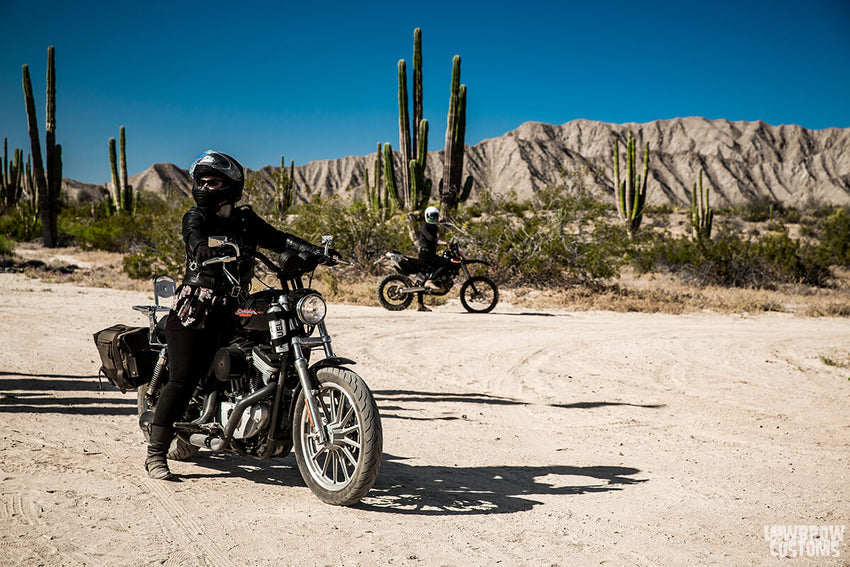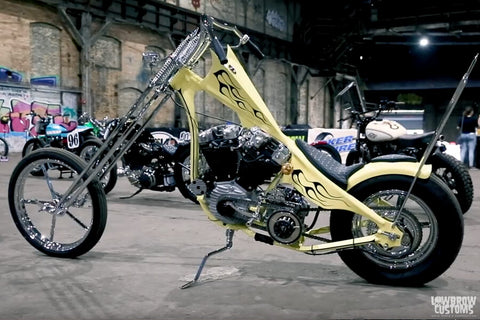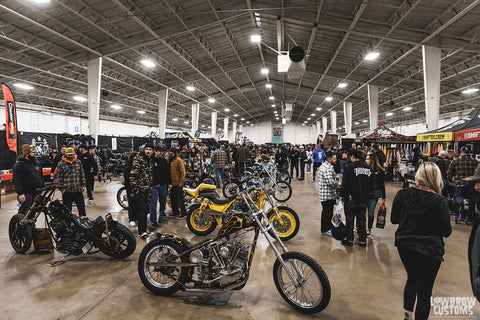Motorcycling is a seasonal sport, and we’ve all gotta get our miles in when we can. Most of us aren’t blessed with a year-round riding climate, which means riding motorcycles in hot weather is a must.
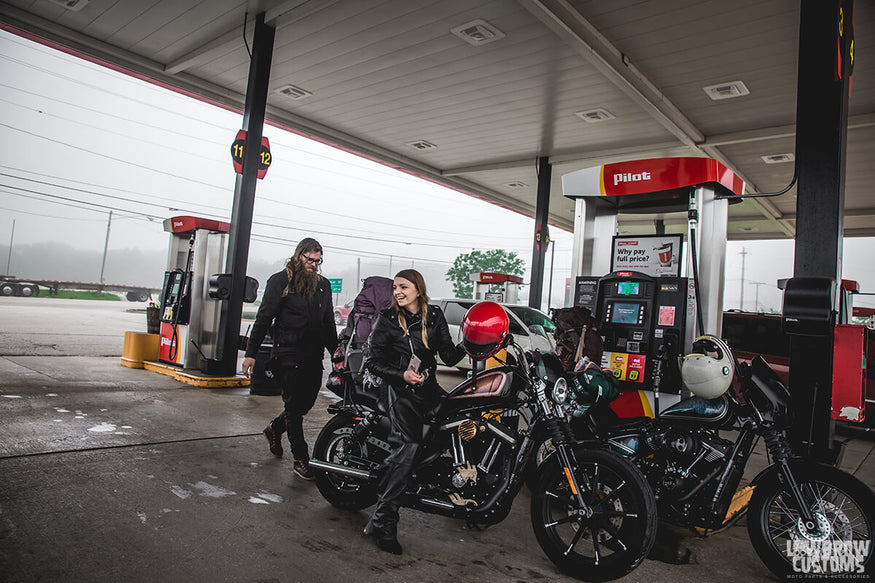 Cold and wet morning run to the Catskills with Endjis and Julie.
Cold and wet morning run to the Catskills with Endjis and Julie.
Look, we get it: Some folks love riding in the cold, and don’t mind the freezer-burnt hands, numb feet, and rosy cheeks that come with the territory. Personally, we’ll take the sweaty arse, blazing blacktop, and occasional sunburn over cold alternatives anyday, but if you’re gonna ride in the heat, you’ve gotta come prepared. Here’s how to go about that.
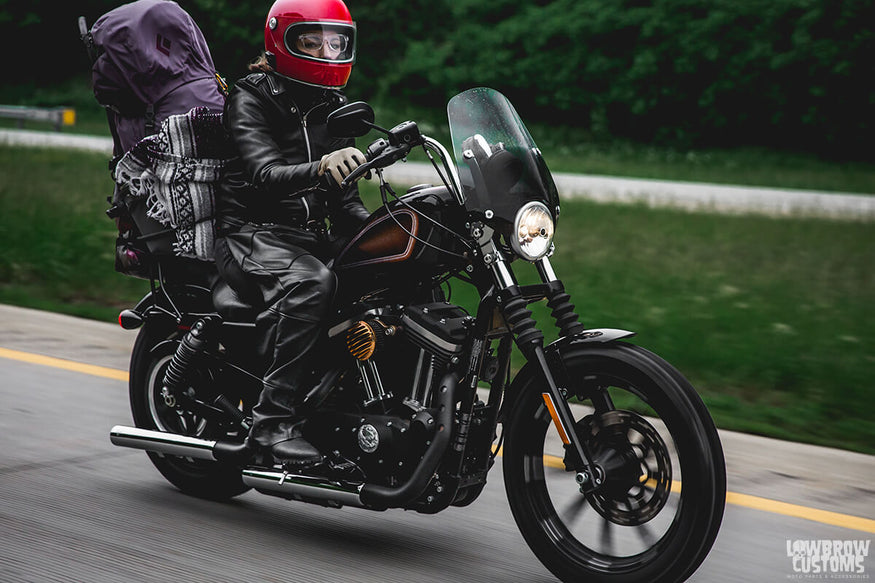 Julie wears full leathers when it's cold. Burrrr
Julie wears full leathers when it's cold. Burrrr
Hot Weather Motorcycle Riding Tips
Stay Hydrated
Motorcyclists are constantly exposed to the elements, which means you should approach riding a motorcycle in hot weather the same as any outdoors activity when it comes to hydration.
 Jen after a long ride getting some water in her Lowbrow Customs Stay Hydrated water bottle out of her Carrier 2.0
Jen after a long ride getting some water in her Lowbrow Customs Stay Hydrated water bottle out of her Carrier 2.0
With zero air conditioning to speak of, a hot engine underneath you, and (hopefully) a full suit of protective gear on, you’re going to sweat, no two ways about it. There are a few things you can do to minimize the drip, but the simple fact is that your “swampier” regions are going to cry big salty tears constantly throughout the day.
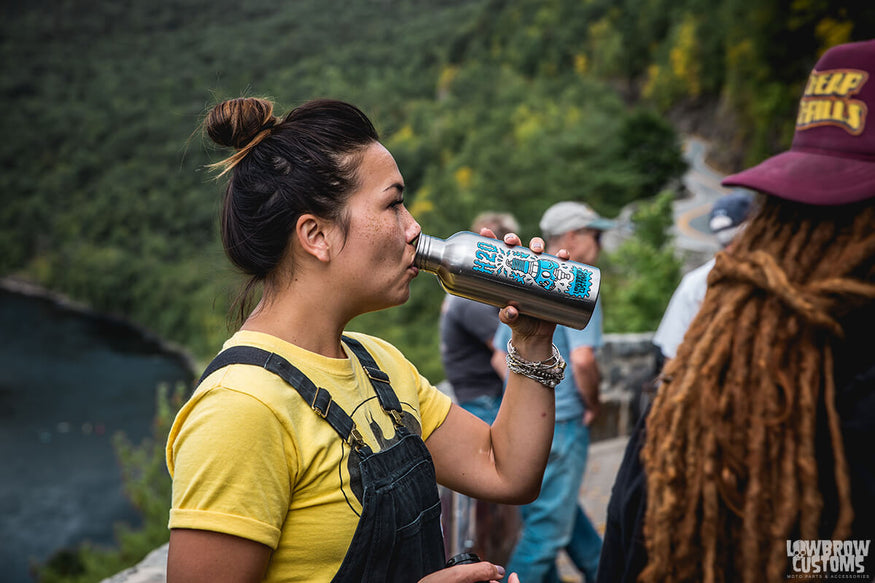 Stay hydrated people!
Stay hydrated people!
Your first line of defense here is to drink plenty of water both before your ride and throughout the day. Drinking water before you ride (aka “pre-hydrating”) is important because if you wait until you’re thirsty to drink, you’ve already lost the battle and will be playing catchup for the rest of the day.
We recommend guzzling a good 20 oz/600ml or so of water before starting out (about 3ml per pound of bodyweight is a good benchmark here), and continuing to drink at regular intervals throughout the day. Staying hydrated keeps your body’s natural cooling system in good working order, and also prevents the sort of fatigue and exhaustion that can lead to unsafe riding conditions as well.
Base Layers Are Your Friend
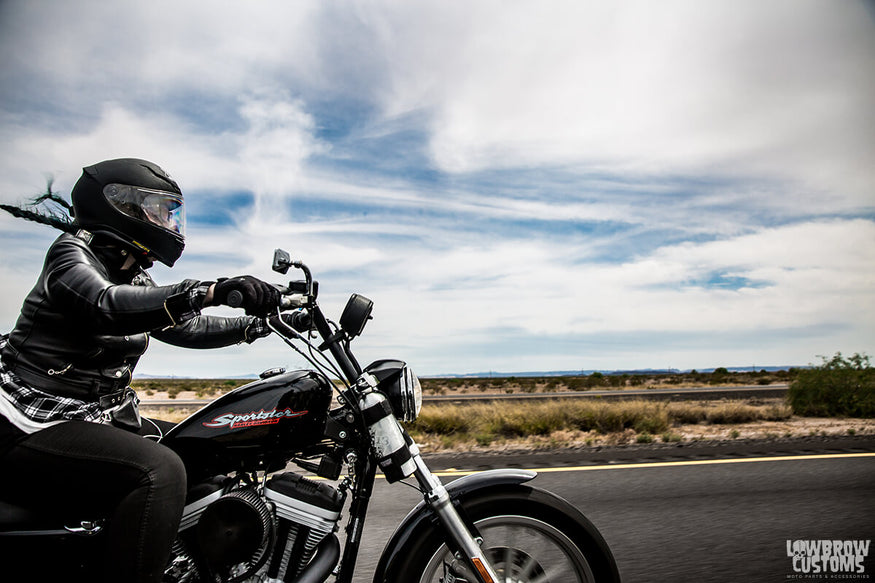 Kat is the queen of layers. She always wears a T-shirt, wool flannel and a jacket and if she gets too hot, she loses a layer.
Kat is the queen of layers. She always wears a T-shirt, wool flannel and a jacket and if she gets too hot, she loses a layer.
This may sound counterintuitive, but wearing layers under your riding gear is just as important in the hot months as it is in the cooler ones. Specifically, you want to wear base layers that are moisture-wicking and fast drying.
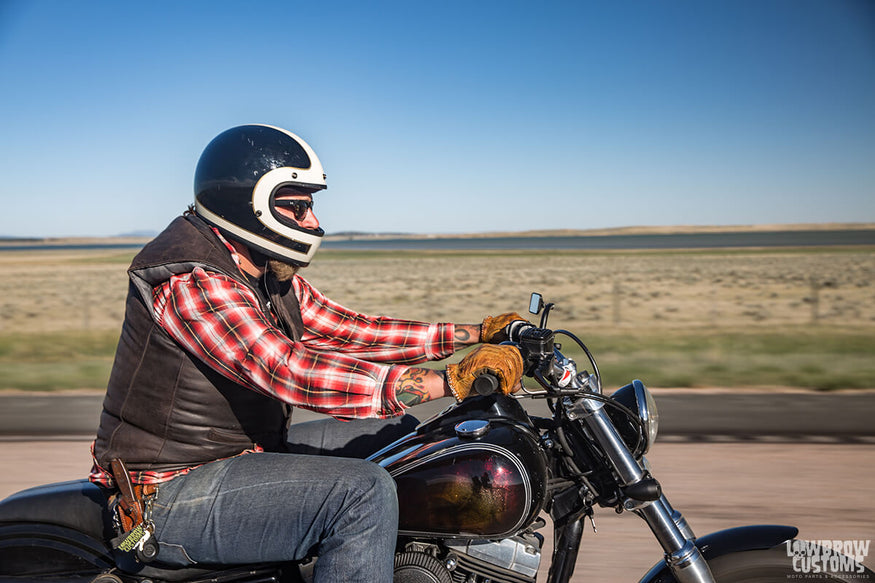 Kyles pretty darn good at layering up too.
Kyles pretty darn good at layering up too.
That means sticking with garments made from either synthetic fibers (like polyester) or natural, non-cotton fibers like merino wool. Wearing wool base layers while riding motorcycles in hot weather may sound like a recipe for heat stroke, but a thin merino wool shirt is arguably the most comfortable thing you can have sitting on your skin. Wool also happens to be naturally odor-resistant, which means you’ll smell less like a gym locker room after a long ride.
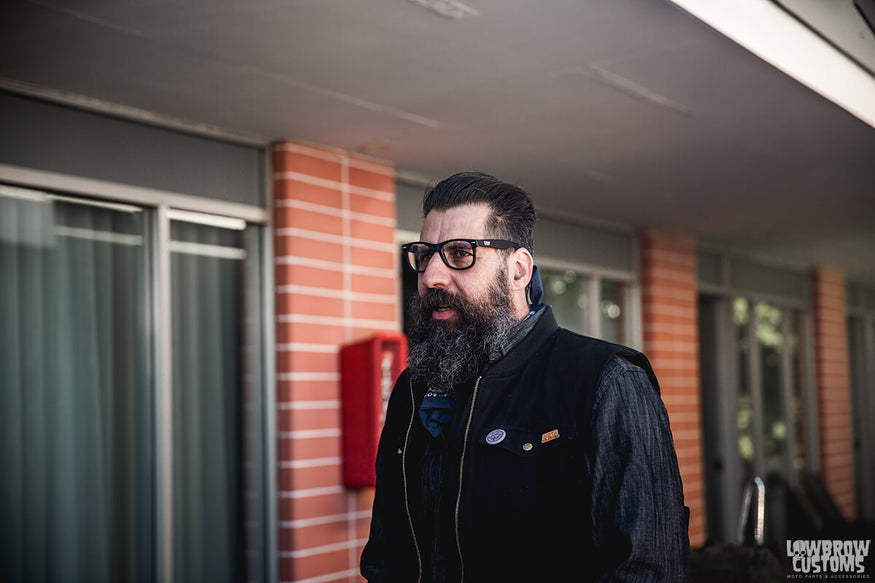 Andy rocking an undershirt long sleeve button up and a vest for comfort along with a bandana on his neck to keep the sun off it.
Andy rocking an undershirt long sleeve button up and a vest for comfort along with a bandana on his neck to keep the sun off it.
Regardless of which materials you choose, base layers like these pull sweat from your skin and boost your body’s natural ability to regulate temperature through evaporative cooling. As an added bonus, full-length base layers also protect your skin from the sun’s harmful rays, so anywhere you’re covered by a base layer, you don’t have to worry about applying (and re-applying) sunscreen.
Start Early
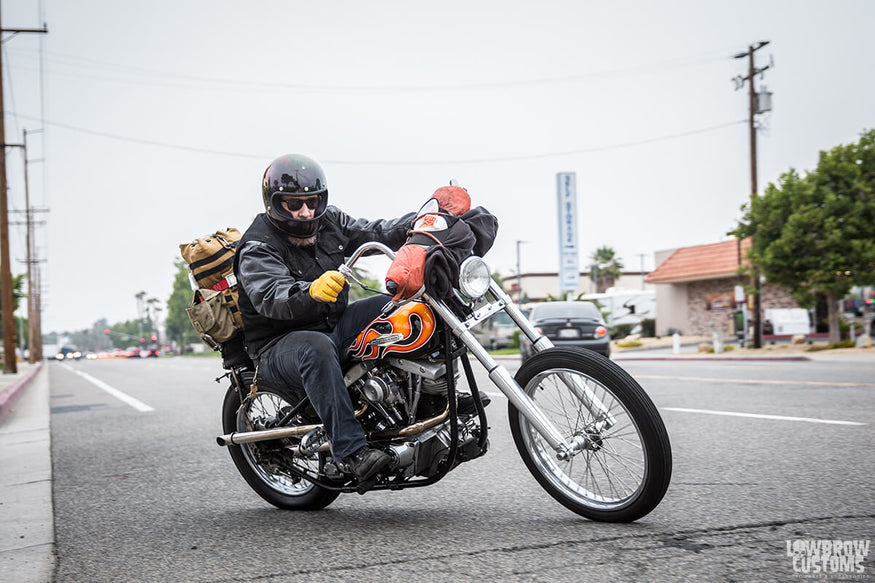 Kickstands up at 8am or Bill will leave your ass.
Kickstands up at 8am or Bill will leave your ass.
As anyone who’s ever done yard work in the summer can attest, the sun is at its worst in the afternoon. Specifically, between the hours of 3pm and 5pm. For this reason, it’s best to start your summer rides as close to daybreak as possible.
 7am coffee and bike packing.
7am coffee and bike packing.
If you stop and think about it, early starts are a win-win scenario from any angle. Getting out and riding early often means having the best stretches of road to yourself, having plenty of time to stop and enjoy the scenery, and having the perfect excuse to plan for a late lunch when your favorite restaurants aren’t overcrowded. With that being said, we aren’t recommending riding non-stop from sunrise to 3pm either, which brings us to our next point.
Take Breaks
Not all riding is physically demanding, but regardless of what you ride (and how you ride it), taking regular breaks is always a smart idea when the temperatures climb. You’ll get a chance to catch your breath and take in your surroundings, but that’s not the only reason why stopping is important when riding a motorcycle in hot weather.
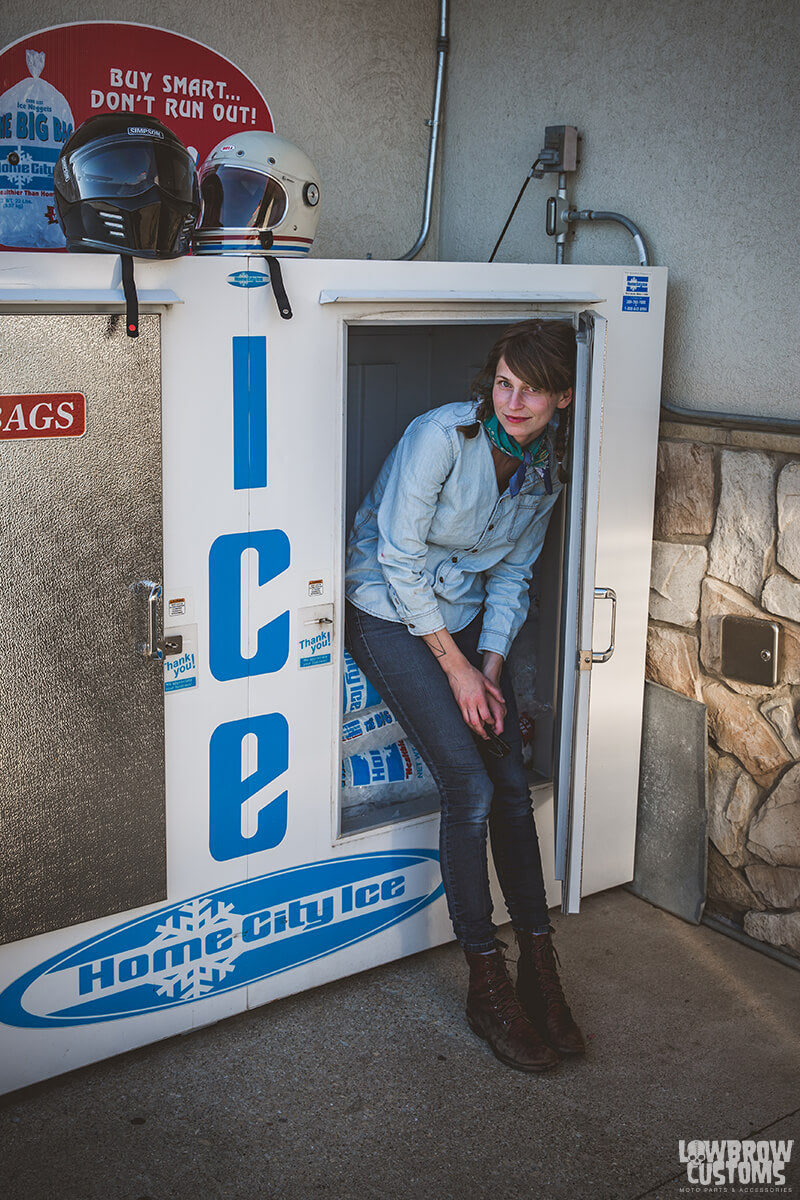 Pro tip: On a super hot day, if the ice chests are open at a gas station, put your helmet in there for a few minutes and or your whole body... "I want to live in here" - Julia
Pro tip: On a super hot day, if the ice chests are open at a gas station, put your helmet in there for a few minutes and or your whole body... "I want to live in here" - Julia
The first and most obvious reason why regular breaks are important is that whole hydration thing we mentioned earlier. Sure, you can always keep a hydration pack within arms reach, but most riders don’t and even if you do, taking your hands off the bars to grab regular sips is inconvenient and even a little sketchy depending on the road.
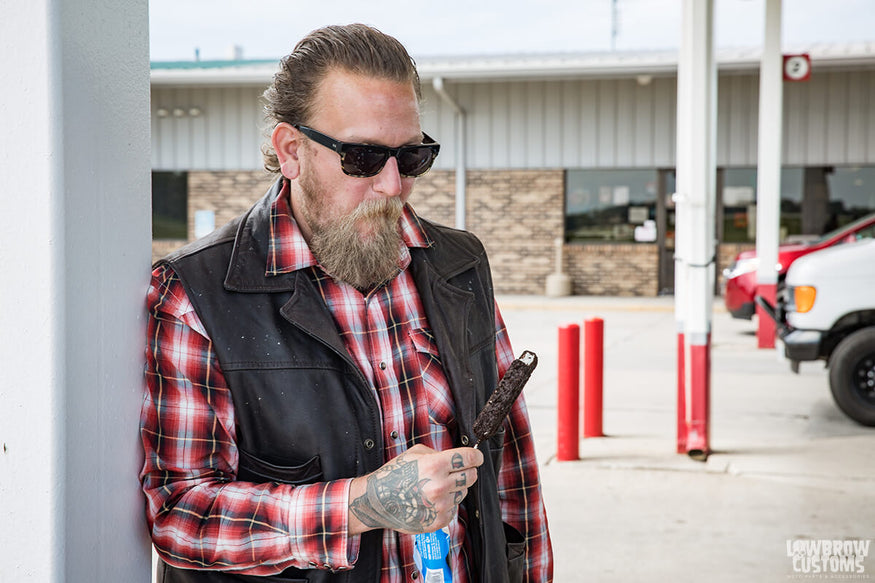 Ah, the best kind of break, an ice cream break. Kyle knows!
Ah, the best kind of break, an ice cream break. Kyle knows!
Your second reason for stopping is for snacks. Most of us don’t need an excuse eat as many snacks as possible throughout the day, but when you’re on a pristine 100-mile stretch of road, stopping just feels wrong. As we stated above, riding in the heat is sweaty work, and if you’re sweating, you’re burning calories and shedding electrolytes.
Stopping to “put a little fuel in the tank” helps keep your energy levels up throughout the day, and just like water, helps to prevent exhaustion and fatigue. We recommend sticking with salty snacks like trail mix, washed down with plenty of fluids, as sodium keeps your muscles functioning properly and helps regulate your body’s natural balance of water and minerals.
Stick To Hot Weather Motorcycle Gear
We’ll put this plainly: Riding in shorts, a t-shirt, and (god forbid) flip-flops is always a bad idea. Look, we get it: Riding in inappropriate clothes for the sake of comfort is tempting, but so is wearing Crocs in public (or anywhere, for that matter), and neither choice is worth the cost.
 What not to wear on your motorcycle adventure. Thanks Kyle for modeling.
What not to wear on your motorcycle adventure. Thanks Kyle for modeling.
For this reason, rather than leaving the gear at home, we recommend investing in some good hot-weather gear. Here are the cliff notes on how to go about that.
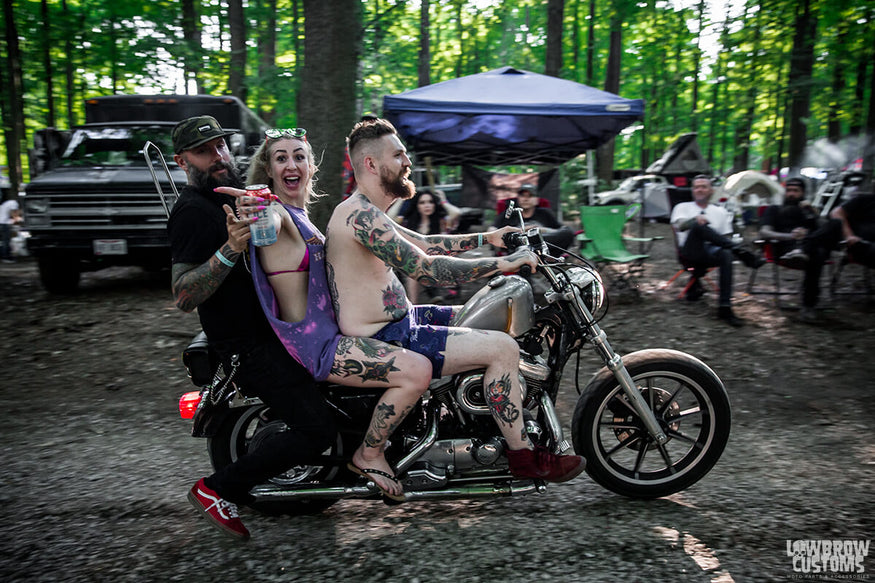 Flip flops on a motorcycle equal no bueno But hey least they are having fun.
Flip flops on a motorcycle equal no bueno But hey least they are having fun.
What To Wear When Riding A Motorcycle In Hot Weather
One of the most helpful hot weather motorcycle riding tips we can share is to dress for the occasion: Lucky for all of us, the motorcycle gear market has grown to Triumph Rocket-sized proportions over the last decade or so, and hot weather safety options are as diverse as they are abundant.
Helmet
When it comes to hot weather helmets, you’ve got two main choices: Full face helmets, and everything else.
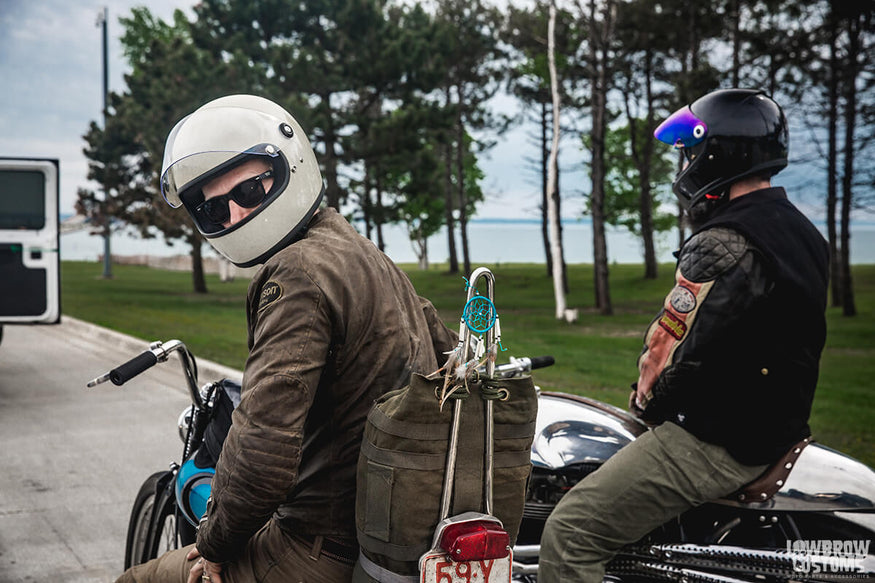 Get yourself a comfortable helmet for yourself. Tyler loves the Biltwell Gringo S for the versatile use of flipping the shield up when it gets too hot which allows for maximum air flow but can be flipped down in the rain or on a highway.
Get yourself a comfortable helmet for yourself. Tyler loves the Biltwell Gringo S for the versatile use of flipping the shield up when it gets too hot which allows for maximum air flow but can be flipped down in the rain or on a highway.
In the latter category, you’ll find both half and three-quarter helmets, which, due to their open-face layout, are going to flow more air than pretty much anything else on the market. Three-quarter helmets are arguably the smarter choice between the two as they beef up the safety factor around the back and sides of your head, but remember safety isn’t a strong suit of either choice.
Many riders are willing to swap some coverage for style points, and to each their own on that count, but keep in mind asphalt and your face aren’t going to mix well should things go sideways.
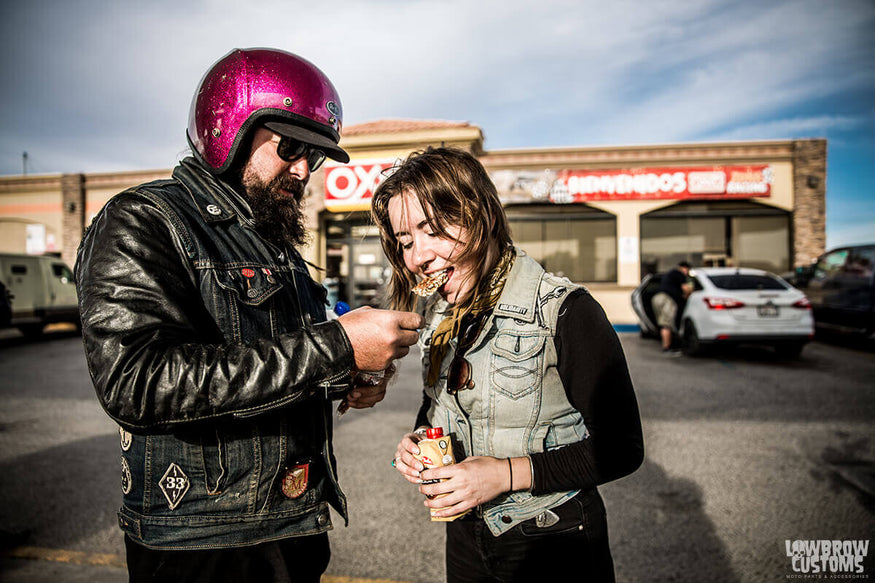 A 3/4 does allow you to wear a hat underneath, well some of them anyway.
A 3/4 does allow you to wear a hat underneath, well some of them anyway.
Full-face helmets, on the other hand, offer greater protection at the cost of some airflow. For that reason, we recommend shopping for full faced models with as many large vents as possible, both in the front and rear of the helmet. Both intake and exhaust vents are important here, as the intakes pull in cool air from outside and the exhaust vents suck hot air and moisture out from inside the helmet.
 Julia rocking a Bell Bullet and Kyle with a Biltwell Gringo. Two polar opposites of helmets in comparison of comfort and noise levels but both full face helmets nonetheless.
Julia rocking a Bell Bullet and Kyle with a Biltwell Gringo. Two polar opposites of helmets in comparison of comfort and noise levels but both full face helmets nonetheless.
Hot weather motorcycle riding tip: Two popular alternatives are modular helmets and dual sport helmets, and both are smart options. Modular helmets are nice because you can flip them up (when stopped) to keep your face from cooking when there’s no air flow.
Dual sport helmets are great for riding motorcycles in hot weather as well because they are designed for maximum air flow and because they allow you to wear goggles with an open visor, which dramatically increases air flow into the helmet while also protecting your eyes from sun, wind, and debris.
 Pro Tip: Wet down a bandana with cold water and tie it to your head to cool off in the shade. Snake knows best!
Pro Tip: Wet down a bandana with cold water and tie it to your head to cool off in the shade. Snake knows best!
Jacket
Leaving your riding jacket at home can be a tempting proposition in the hotter parts of the year, but again, it’s not worth the risk. Instead, we recommend looking for a breathable mesh jacket that allows for maximum airflow without sacrificing protection.
Wearing a mesh jacket can actually keep you cooler than if just wearing a t-shirt; the mesh keeps sun off of your skin while still allowing airflow.
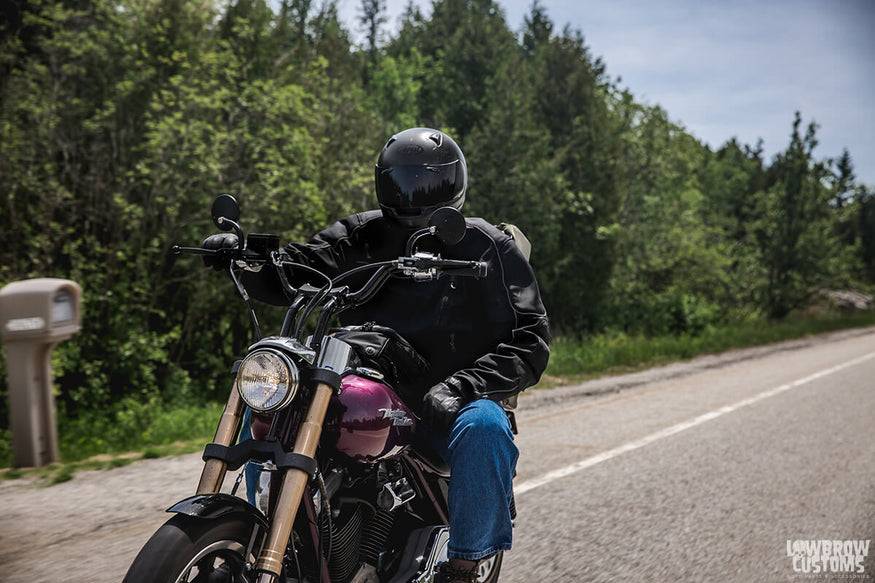 Tim has a really nice kevlar jacket lined with padding to protect him if something would ever happen and he went down.
Tim has a really nice kevlar jacket lined with padding to protect him if something would ever happen and he went down.
One of the best things about mesh motorcycle jackets is that they’re among the least expensive options on the market. Pretty much every major manufacturer nowadays from Klim to Dainese makes a mesh jacket with CE-certified safety chops for under $200, which takes most of the sting out of spending money on a jacket that only works for a few months a year.
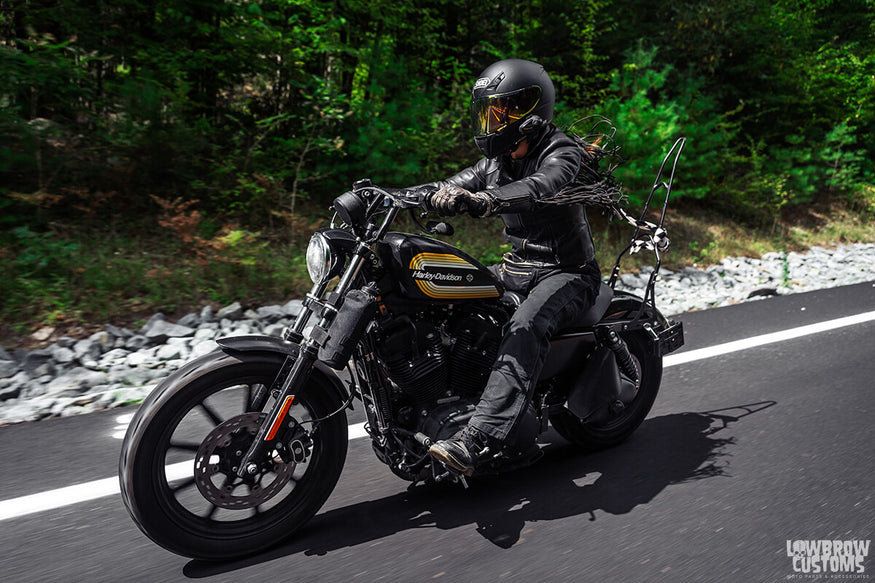 A leather jacket does protect from elements, road debris and help protect your body if you were to go down.
A leather jacket does protect from elements, road debris and help protect your body if you were to go down.
Hot weather motorcycle riding tip: Regardless of how much or how little you spend, remember that even the most expensive summer jackets on the market will hurt both your body and wallet less than going to the hospital for skin grafts, and that’s money well spent in our book.
Pants
There’s a fair amount of debate out there about whether anyone actually needs riding pants, but if you’re asking us, the same rules that go for jackets apply here: Better safe than sorry. Fortunately, just like summer jackets, mesh motorcycle pants are typically much cheaper than their heavyweight counterparts, and there are plenty of options out there for well under $200.
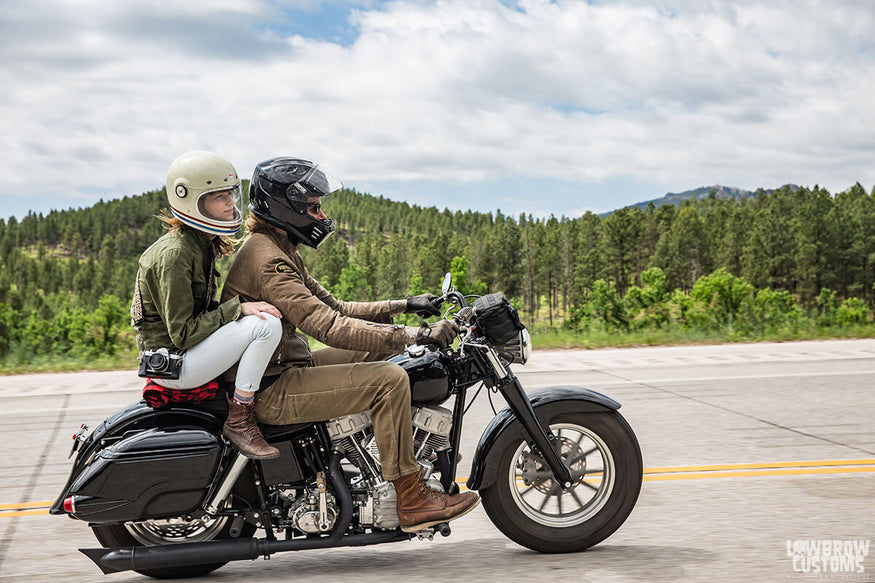 Waxed canvas pants help with the rain.
Waxed canvas pants help with the rain.
A few things to look for when shopping pants for riding motorcycles in hot weather: First, look for options that feature as much mesh/textile as possible without sacrifycing their CE safety certification. Padding and/or armor in the knees and hips is ideal here. Second, look for pants with adjustable vents, preferably on both the front and back of the legs. Just like helmets, dual vents like this help the pants to “breathe” out on the road, giving fresh air an easy entrance and hot air and moisture an easy exit.
Footwear
Hot weather riding footwear mainly comes in two flavors: Ventilated mesh and perforated leather. Both materials serve the same purpose, (maximizing airflow while preserving abrasion resistance), so it’s up to you (and your pocketbook) to decide which works best.
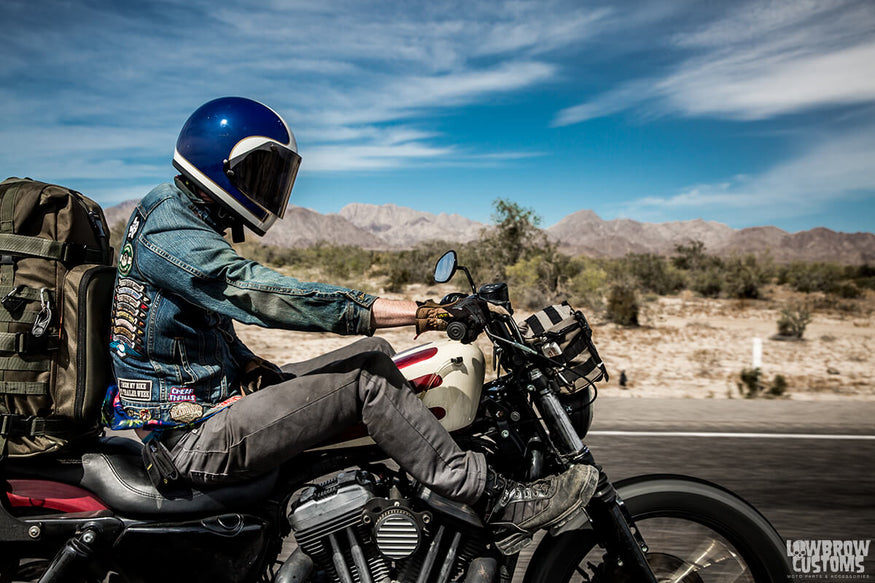 Tyler 1.0 with some high top boots with venting.
Tyler 1.0 with some high top boots with venting.
Personally, we’re a fan of riding shoes for general warm weather use, as they combine a lighter and more breathable design with some casual style that works on and off the bike. The best options include impact protection on both sides of the ankles, reinforcements at the heel and toe-box, and soles with rigid shanks to keep your feet from going “full pancake” in the event of a crash.
Gloves
Lastly, we arrive at riding gloves. You’ll find no surprises here, as ventilation is still the name of the game, but you’ve got a dizzying array of options for summer-friendly gloves. Our main advice here is that whichever mix of materials you choose, make sure your gloves have “the good stuff” where you need it.
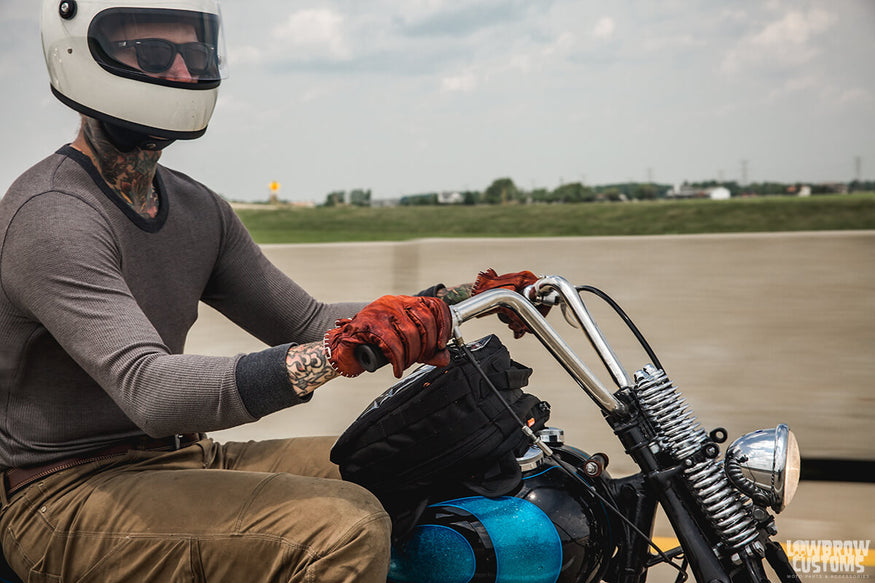 Tyler rocking some MotoStuka shanks, these gloves are good all year around.
Tyler rocking some MotoStuka shanks, these gloves are good all year around.
The main focus here should be on the palms of your hands, which are the most slide-prone area in the event of a crash. Our ideal hot weather gloves use full grain (non-perforated) leather throughout the underside of the glove, and also include additional reinforcements (whether that’s hard sliders or leather-wrapped padding) at the heel of your hand. Additional protection along the knuckles and the ends of your fingers is an added bonus, but again, it’s the underside that does the lion’s share of the work here.
 A nice pair of gloves can dampen the shake of the motorcycle, keep your hands clean and also safe if something were to go down.
A nice pair of gloves can dampen the shake of the motorcycle, keep your hands clean and also safe if something were to go down.
Hot weather motorcycle riding tip: Hot weather motorcycle gloves are one of the least expensive pieces of gear you’ll buy, and there are dozens of options out there. The cheaper models often use layers of synthetic leather (also called Clarino) along the palms to cut costs, but full grain leather is always preferable.
We recommend dropping an extra $10-$20 on a pair with full leather palms whenever possible, as it beefs up the slide protection without adding a ton of bulky material between your hands and the controls of your bike.
Sunglasses
While wearing a full face helmet the face shield will cut down the UV rays, keeping you cooler, and helping avoid sunburn. Tinted shields are available, and the norm, on most helmets. That being said, packing a pair of sunglasses for those hot weather rides can prove very useful.
 Wearing sunglasses with Virginia Cagney
Wearing sunglasses with Virginia CagneyYou may want to double up with sunglasses in addition to your helmet, depending on the level of tint, should you be riding somewhere particularly sunny and bright. Also, at gas stops, while taking breaks during your ride, or while simply enjoying the destination, don’t forget to bring along a pair of sunglasses to keep your eyes protected while not wearing a helmet!
 Pretty sure Jay Cagney has some glasses on underneath that bubble shield.
Pretty sure Jay Cagney has some glasses on underneath that bubble shield.If you follow these tips you will be able to handle riding in hot, sunny weather with ease. Be sure to protect your body, stay hydrated, and take frequent rests (which are good for your body as well as your motorcycle!). A bit of preparation and thought will keep your ride just as it should be… enjoyable!
Related Products










